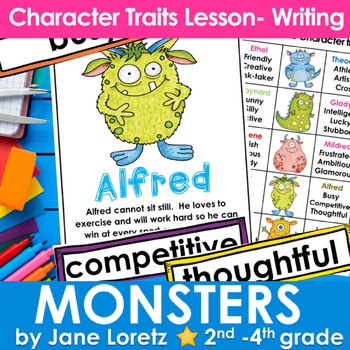Monster Character Traits Lesson, writing - second grade, third grade
- PDF
What educators are saying
Description
This monster lesson on Character traits is fun and engaging! A wonderful literacy character traits lesson with a monster theme that will help your students have a greater understanding of what character traits are and how to identify them. I love doing this Monster Character Traits Lesson during October as a Halloween activity, however this activity can be done any time of the year. My students loved it and I know your students will too!
In this lesson your students will be identifying character traits of different monsters. They will have to infer based on the details that are given for each character. This is good practice because students will be required to identify character traits in texts and they need a background on what character traits are and how to identify them.
First you will read the monster posters to your students and display them where your students can see them.
Next when you are done reading all the monster posters, you will go through each character trait and discuss what they mean. The character traits are on the colored frames.
Then one at a time you will reread the different monster posters and have your students identify the character traits for each monster.
(There is an answer sheet for you.)
Then you will display the character trait cards with the monsters.
When your lesson is all done you will have your students write and create their own monsters.
Planning pages and paper are included for the monster drawing and the monster writing. Three different letter spacing available.
I like to print all the posters and character trait frames on card stock for better results.
Your students will have a greater understanding of character traits after this lesson and they will have a great time creating their own monsters.
Included also are character trait posters and 33 different character trait definition cards. These include synonyms.
Also a link to Seesaw for the character trait lesson to do on there for students who are learning at home.
What are other teachers saying...
"My students loved doing the Monster Traits!!! I introduced the character and they had to infer what their traits were, then at the end of the unit the students designed their own monsters and wrote about them using the different traits. Great resource!!!!" ⭐⭐⭐⭐⭐Extremely satisfied Angelia
"My students and I all LOVED this resource!! Such a great way to develop their understanding of character traits!! I used the posters during an evaluation and my principal commented about how this was such a great way for students to see character traits in a clear manner. LOVE it!!" ⭐⭐⭐⭐⭐Extremely satisfied Amy F.
"This may be one of my all time favorite TPT purchases. My students had the BEST time creating monsters and giving them backstories based on their character traits. My most reluctant writers were creating multiple stories and beyond proud of their work!" ⭐⭐⭐⭐⭐Extremely satisfied Betsy Knight
Please see PREVIEW for a good look.
Happy teaching! Jane





